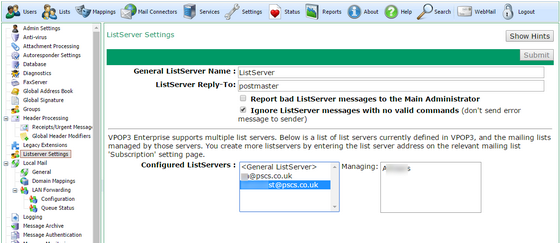
To get to this page, go to Settings → Listserver Settings
When you are using Mailing Lists in VPOP3, some of the features, such as user subscription/unsubscription are managed by an automated service called the ListServer. This settings page lets you configure how that works.
See the ListServer reference topic for details of the available commands.
The General ListServer Name is the name part of the email address which will normally be used for sending messages to the list server. For instance, if the name is ListServer, then you would send commands to the list server by sending them in an email to listserver@<mydomain>. In VPOP3 Basic, there is only this one list server address available. In VPOP3 Enterprise, you can create multiple list servers with different email addresses if you wish.
The ListServer Reply-To name is the email address which is used in the 'Reply-To' field of acknowledgement & error messages sent by the list server. This is usually set to a real person, so that if a user inadvertently replies to a listserver message it goes to a person rather than back to the list server (where it will probably generate errors).
The Report bad ListServer messages to the Main Administrator option tells VPOP3 that if it receives command messages to the list server which contain errors, it will report them to the VPOP3 Main Administrator. This option can be useful if you want to be able to see this happening and proactively help users. However, nowadays, it is likely that the list server will receive lots of unsolicited messages (spam) so it is likely you will want to ignore these bad messages.
The Ignore ListServer messages with no valid commands option tells VPOP3 that if it receives an email message containing NO valid ListServer commands, then it will simply ignore the message and throw it away. This is useful for reducing 'backscatter' from spam messages. If the incoming message contained at least one valid command, then the list server will still respond with error messages for any invalid commands in that message, but if there are no valid commands at all, it will ignore it.
If you have VPOP3 Enterprise, then the bottom half of the page lets you see which List Servers you have defined, and which Mailing Lists those manage. This is configured in the Mailing List's Subscriptions tab, not in this page.

